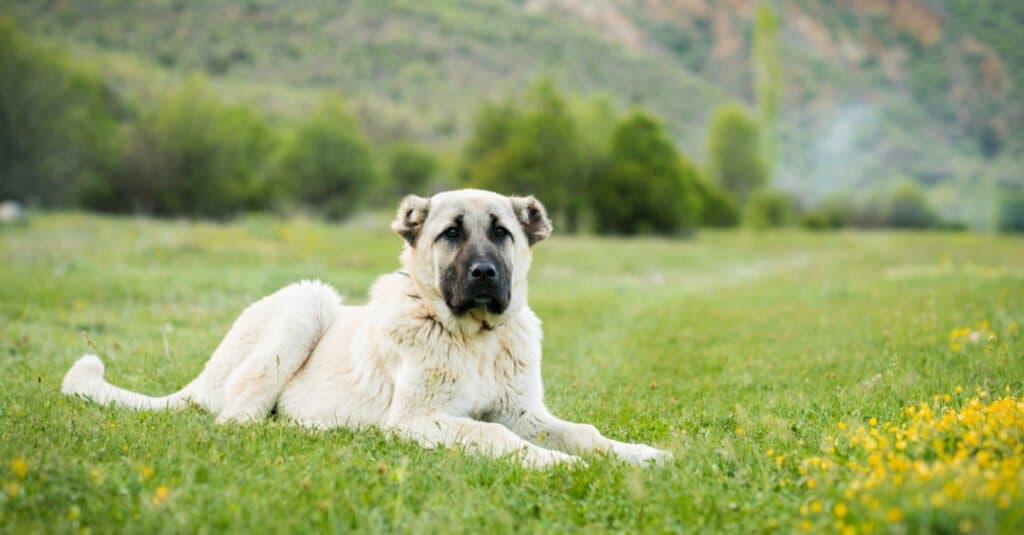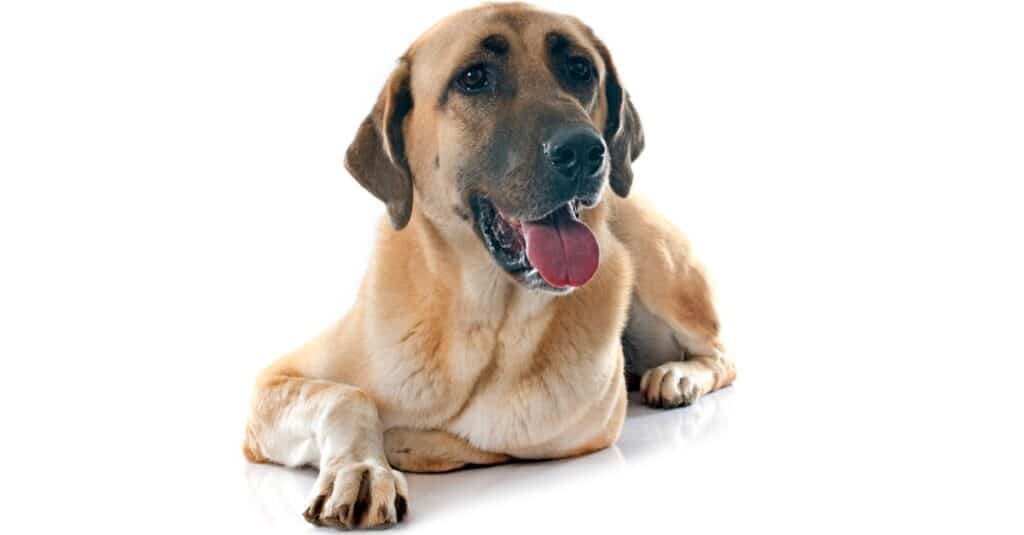Boz shepherds and kangals are both from Turkey and share a common ancestor. This explains why they’re so difficult to tell apart! Boz shepherds are bred to withstand either high or low extreme weather conditions. They have a very low prey drive. Kangals are large dogs well-suited to farm life, the outdoors, and work. They are not a breed to live happily lying around a kennel.
Keep reading to learn more about these guardian breeds and which, if either, is right for you and your family.
Comparing Boz Shepherd vs. Kangal

Kangals make great companions and need a lot of activity to stay happy and healthy.
©shodography/Shutterstock.com
| Boz Shepherd | Kangal | |
|---|---|---|
| Size | 26.5-35.5 inches, 110-190 pounds | 28-32 inches, 90-145 pounds |
| Appearance | Blocky head, proportionate body | Long body with shorter legs, round head |
| Temperament | Working dog, strong guarding instincts | Working dog, strong guarding instincts |
| Energy Level | Very high | Very high |
Key Differences Between Boz Shepherd and Kangal
The key difference between a Boz shepherd and a kangal is size and body proportions. Otherwise, these livestock guardians are remarkably similar! Let’s dive into their differences below and talk more about these breeds, so you can decide if either one is right for you.

Boz shepherds can weigh between 110-190 pounds.
©turkishboz.com / CC BY-SA 4.0 – License
Boz Shepherd vs. Kangal: Size
Kangals are giant dogs measuring 28-32 inches in height and weighing up to 145 pounds — but Boz shepherds are even larger!
Male Boz shepherds stand 28.5-35.5 inches tall and weigh between 120-190 pounds. Females tend to be smaller, measuring as little as 26.5 inches and 110 pounds.
These breeds’ size is a crucial consideration if you’re looking for a new pet. Giant breeds tend to be lovable, beautiful dogs inside and out. But they also have a number of drawbacks.
- First, giant pups produce giant bills! They’ll cost more to feed, vet, house, and provide for. You might even have trouble finding products, such as harnesses or dog beds, that are large enough for them!
- These dogs need a large yard and plenty of daily exercise — there are really no exceptions to this. They aren’t suited for apartment life or exercising indoors.
- If a crisis hits, heavy dogs are difficult to get to the veterinarian because you might need multiple people to lift them! They might also be hard to handle on a leash due to their weight and strength.
- Lastly, giant breeds unfortunately live shorter lives than smaller breeds.
That said, these dogs excel at what they were bred for. They’re excellent guard dogs and have strong protective instincts when it comes to their family. One thing’s for sure: no one’s getting past a dog of this size!
Boz Shepherd vs. Kangal: Appearance

Close-up of a Kangal. Kangals have rounder heads, while Boz shepherds have boxier heads.
©iStock.com/BiancaGrueneberg
These dogs have only slight differences in appearance. It’s very easy to confuse one for the other!
Boz shepherds tend to have boxier heads, while kangals’ heads are more rounded. Boz shepherds are also as tall as they are long.
Kangals, on the other hand, are longer than they are tall. While not disproportionate to the extent of, say, a Corgi, these pups do have long backs when compared to Boz shepherds.
Both breeds are giant, muscular, and take on a strong appearance. They’re known for taking down large predators to protect livestock and require a great deal of strength to do so!
Boz Shepherd vs. Kangal: Temperament
Both dogs are known to be excellent livestock guardians. They’re giant working breeds that require a lot of space, training, and exercise. These pups will protect those they consider family at all costs, including livestock, other pets, and their human families. They may be unfriendly toward strangers, particularly those who pose a real or perceived threat such as coming onto the dog’s property.
However, they’re also good family dogs. Both are known for being excellent with children, particularly those in the family. That said, never leave any dog and child unattended. One could easily hurt the other. It’s important to teach the dog and child how to interact with one another appropriately. We suggest you discourage rough play, teach children how to pet dogs gently, and teach your dog not to jump or nip. Children should also be kept away from a dog’s food.
Although these breeds are good for families, they’re not good for the average family. This is because of their high needs for exercise, work, and space. These dogs do best on a farm.
The second-best thing for them is to have a dedicated family who are committed to providing ample daily exercise and satisfying their mental needs. In this case, the dogs still need a large yard to play in or access to a large, enclosed space to run daily. Not providing for your dog’s needs will lead to a number of behavioral issues that may include destructive chewing, excessive barking, and more.
Boz Shepherd vs. Kangal: Energy Level

Both breeds are high-energy,
working dogs
that aren’t suited to many lifestyles.
©iStock.com/cynoclub
As discussed above, both breeds are incredibly high-energy. They excel at tasks that involve endurance, such as hiking, long walks, and patrolling a large backyard.
Keeping these dogs without farmland will become a lifestyle and full-time job. They’ll need long daily exercise and mental enrichment — leaving them alone in the backyard won’t be nearly enough to keep them occupied. Some people thrive when living life around their beloved pup, but most families will do better with a different breed.
Boz Shepherd vs. Kangal: Puppyhood

Kangals are wonderful family dogs, offering both play and protection for children.
©ehasdemir/Shutterstock.com
The last thing we’ll discuss when it comes to these breeds and whether they’re right for you is puppyhood. Giant breeds develop slower than other dogs, meaning their puppyhood lasts until around two years of age. And they’re big puppies!
Remember when we discussed the costs of owning these dogs earlier? We should have added on the cost of replacing things they destroy in their puppy years! We aren’t talking about your favorite pair of shoes — though they might chew those, too — but large items like your couch. These kinds of large items can often be a target for those big puppy teeth.
Keeping your dog safe and free of digestive obstructions, and keeping your things intact, can be even more of a challenge with these strong and tall dogs! They can get into much more trouble than a tiny puppy could.
Giant pups take a lot of patience, physical strength, and training skills. You’ll need that physical strength to, say, hold them back on a leash when they’re feeling rebellious! Training large dogs well is also vital to your safety, as well as the safety of your dog and the people and animals around you.
Up Next:
- Anatolian Shepherd vs. Kangal: Is There a Difference?
- Kangal vs. Lion: Who Would Win in a Fight?
- Kangal vs. Cane Corso: What’s the Difference?
- 8 Best Guard Dogs
The photo featured at the top of this post is © iStock.com/klenger
Ready to discover the top 10 cutest dog breeds in the entire world?
How about the fastest dogs, the largest dogs and those that are -- quite frankly -- just the kindest dogs on the planet? Each day, AZ Animals sends out lists just like this to our thousands of email subscribers. And the best part? It's FREE. Join today by entering your email below.
Sources
- Wiley Online Library, Available here: https://onlinelibrary.wiley.com/doi/abs/10.1046/j.1439-0264.2001.00292.x
Thank you for reading! Have some feedback for us? Contact the AZ Animals editorial team.






